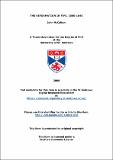Files in this item
The Reformation in Fife, 1560-1640
Item metadata
| dc.contributor.advisor | Mason, Roger A. | |
| dc.contributor.author | McCallum, John | |
| dc.coverage.spatial | 237 | en |
| dc.date.accessioned | 2009-02-03T16:34:24Z | |
| dc.date.available | 2009-02-03T16:34:24Z | |
| dc.date.issued | 2008-11-27 | |
| dc.identifier.uri | https://hdl.handle.net/10023/638 | |
| dc.description.abstract | This thesis traces the establishment and development of a functioning reformed church in the parishes of Fife after the official Reformation of 1560. Based principally on archival sources, especially the records of the kirk sessions which governed the church at parish level, it examines how ecclesiastical institutions developed and interacted with laypeople, and evaluates the progress made in the challenging task of inculcating Protestant values and identity in Fife’s parishioners. The first section examines the development of the reformed church in three chapters on the parish ministry, church discipline, and reformed worship respectively. The progress made in providing parish ministers and establishing kirk sessions was hesitant, and it took several decades before the church’s institutions were functioning healthily across Fife. This gradual process of reformation was not what the original reformers wanted, but it may have in fact eased the transition to the more firmly Protestant parish culture that emerged around the turn of the century. The second section looks more thematically at three key aspects of the church, focusing mainly on this latter period. The fourth chapter analyses the ministry as a profession, while the fifth chapter goes on to discuss the efforts made to instruct the laity in more detailed Protestant understandings from the 1590s onwards. The sixth and final chapter returns to the subject of discipline, describing the main targets of the disciplinary regime and evaluating the effectiveness of discipline. The church that emerged in the seventeenth century was relatively healthy, staffed by a stable and well-educated ministry, and was starting to make much stronger efforts to educate and discipline the laypeople of Fife. The thesis concludes that while the Scottish Reformation still emerges as an ultimately successful transformation, the path to religious change was more complicated than has been appreciated by historians. | en |
| dc.format.extent | 1357411 bytes | |
| dc.format.mimetype | application/pdf | |
| dc.language.iso | en | en |
| dc.publisher | University of St Andrews | |
| dc.rights | Creative Commons Attribution-NonCommercial-NoDerivs 3.0 Unported | |
| dc.rights.uri | http://creativecommons.org/licenses/by-nc-nd/3.0/ | |
| dc.subject | Scottish Reformation | en |
| dc.subject | Fife | en |
| dc.subject | Religious history | en |
| dc.subject | Early-Modern Scotland | en |
| dc.title | The Reformation in Fife, 1560-1640 | en |
| dc.type | Thesis | en |
| dc.contributor.sponsor | Arts and Humanities Research Council (AHRC) | en |
| dc.contributor.sponsor | Burnwynd Trust | |
| dc.type.qualificationlevel | Doctoral | en |
| dc.type.qualificationname | PhD Doctor of Philosophy | en |
| dc.publisher.institution | The University of St Andrews | en |
| dc.publisher.department | Institute of Scottish Historical Research; Reformation Studies Institute | en |
This item appears in the following Collection(s)
Except where otherwise noted within the work, this item's licence for re-use is described as Creative Commons Attribution-NonCommercial-NoDerivs 3.0 Unported
Items in the St Andrews Research Repository are protected by copyright, with all rights reserved, unless otherwise indicated.


